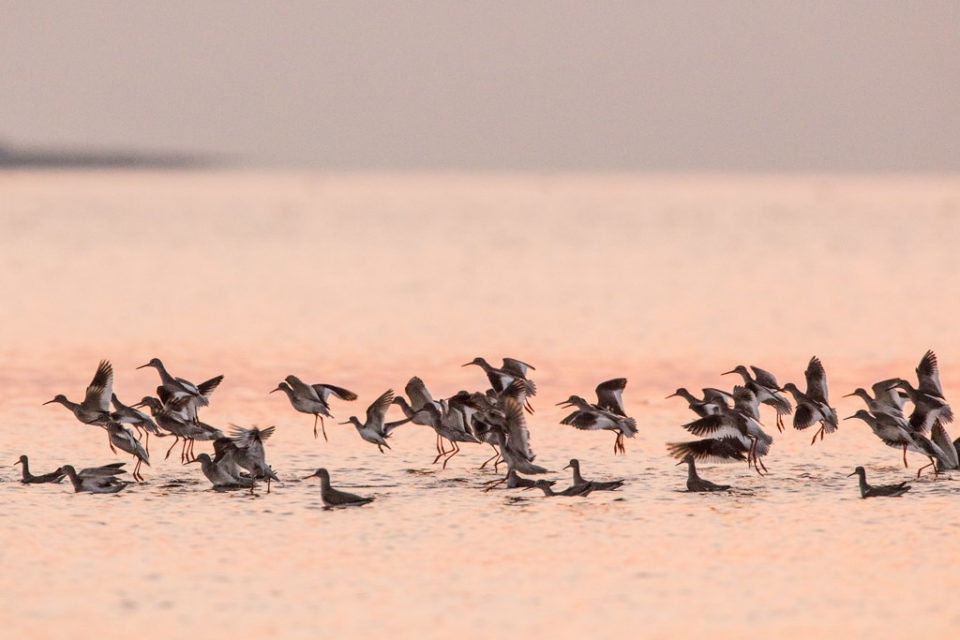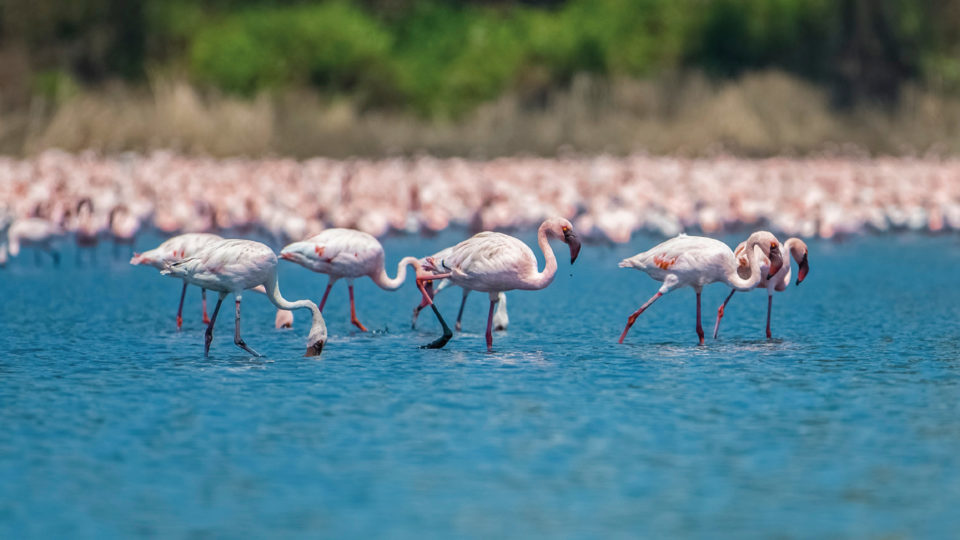
Where water meets land, life takes flight: Celebrating the beauty of wetlands and migratory birds
-
Species
Migratory birds, wetlands, and human beings are all part of a delicate and interconnected ecosystem. While wetland ecosystems provide crucial habitats, the biodiversity they support shapes the natural system and plays a vital role in maintaining the health of our planet’s ecosystems.
Happy World Migratory Bird Day, Ward! We thought it was the perfect time to take a bit of a deep-dive with you into the world of birds, waterbirds in particular! How did your fascination with birds begin in the first place? How old were you then?
When I was a very young boy, in early primary school, I discovered an old booklet on the shelves in our living room. It was a bird field guide that my mom had given to my dad to help identify the birds that he saw out of the window of a sanatorium where he had to spend a long recovery period after a heavy surgery. I was hooked and spent lots of time just flipping through the book. I remember spending a lot of my time looking for birds in the garden, on my way to school, and in local parks, and searching for nests. That was also around the time, I got my first binoculars from my parents. As soon as I was allowed to cycle longer trips alone, I started visiting the wetlands and other areas around Nijmegen, looking for birds. The Ooijpolder became my local patch. I joined the Nijmegen chapter of the NJN, the Netherlands Youth Movement for Nature Study, and spent many hours in the field with friends, cycling all across the Netherlands. It was a wonderful time!
In layman terms, how could we best understand the relationship between migratory birds, wetlands, and human beings?
Migratory birds, wetlands, and human beings are all part of a delicate and interconnected ecosystem. Wetlands provide crucial habitats for migratory birds, which rely on them for food, rest, and shelter during their long journeys. Similarly, healthy wetlands are vital to us as they provide valuable ecosystem services, such as water filtration and flood control, as well as recreational opportunities for our mental well-being.
Biodiversity shapes the natural system and plays a vital role in maintaining the health of our planet’s ecosystems. When there is a high level of biodiversity, it means that many different species of plants and animals are present and interacting with each other in complex ways. This complexity and diversity are what make ecosystems resilient and able to provide benefits to people, In this way, birds can be indicators of the health of the systems.
It It is important to protect our vital ecosystems, including wetlands, and their inhabitants to ensure their (and our) survival for future generations.

What are some of the wetland sites most visited by migratory birds across the different flyways?
Flyways are defined as the total area covered by birds in their annual cycle. That includes places where they safely breed, feed, rest, and sleep, and go through other important steps like changing their feathers (moulting). In all flyways around the world, there are indeed sites where many birds find such favourable conditions and as a result, we can witness a high number of birds in these sites. Some of these sites have become famous for this like the Banc d’Arguin and the Waddensea In the East Atlantic Flyway, the Yellow Sea in the East Asian Australasian Flyway, and Barr Al Hikman in the West Asian – East African Flyway.
There are however many more sites that are critical to the survival of populations of migratory birds. Wetlands International, working in partnership with BirdLife International, have developed an online tool, the Critical Site Network Tool (the name says it all) that allows finding these critical sites for all migratory waterbirds, with their bird numbers, site characteristics, threats, and management requirements, in association with climate change information. So far this tool covers the African Eurasian Flyway region, but it is in principle suited to accommodate such information for the other global flyways as well.
What have some of the most fascinating species of migratory birds that you’ve had a chance to interact with? Please share your experience.
During my study, I worked in Extremadura, Spain, on the Lesser Kestrel, a small insectivorous, migratory raptor, and I fell in love with that species. Later, working for Wetlands International I got more closely involved with migratory waterbirds and I got fascinated by these. I notice that if I get the opportunity to work closely with a species, getting to know and understand its ecology, this creates a connection and fascination. Observing, counting, and following the migration of Garganeys (a small duck species) in Africa with transmitters, in the framework of researching the role of wild birds in the transmission of avian influenza was another such case. And in recent years I have developed a fascination for migratory shorebirds and sites that are a paradise for them, like Barr Al Hikman in Oman.
The best way to connect with nature and migratory birds is to go out and experience them. Observe and realise the changing nature around you at this time of year, for example. Migratory birds are arriving from their non-breeding areas and start singing and building nests. Many of these birds were hundreds, if not thousands of kilometers away, some weeks ago. When out there enjoying their songs and views, think about that and realise how special it is to have these birds come back every year, and how important it is that they find healthy habitats when they get here.

What are some of the astounding (or endearing) behaviours you’ve observed about migratory birds that you’d like people to know?
Migratory birds perform miraculous achievements year after year. Without agendas, navigating software on a phone, or external propulsion they manage to time and execute their daunting travel across large distances in order to survive and contribute to the survival of their populations. For example, as a bird ringer, I experience this every year when I see the same Bluethroat with metal ring returning to the same reedbed year after year or the same colour-ringed Curlew Sandpiper coming back to exactly the same 10 meters of beach in East Africa, after having been on its breeding grounds along the Arctic Ocean in N Russia. In working with transmitters on birds I have seen birds, smaller than a common garden-bird like the Blackbird (Turdus merula), travel 4000km in a non-stop flight on its northward migration, or seen other birds find small temporary wetlands in the middle of huge deserts. Migratory birds never cease to amaze and fascinate me!
For starters, what are some simple ways each of us could do to learn more about migratory birds and do our bit to forge a stronger bond with nature?
The best way to connect with nature and migratory birds is to go out and experience them. Observe and realise the changing nature around you at this time of year (Spring) for example. Living in the temperate region (Netherlands) we can see everything turning green and vegetation growing quickly. A careful observer will notice the birds that were not around some weeks ago – Chiffchaffs singing in the bushes, Swifts flying and screaming overhead. Remember that listening is equally important as watching when you’re tuning in to your environment.
Migratory birds are arriving from their non-breeding areas and start singing and building nests. Many of these birds were hundreds, if not thousands of kilometers away, some weeks ago. When out there enjoying their songs and views, think about that and realise how special it is to have these birds come back every year, and how important it is that they find healthy habitats when they get here. And if you have the chance to observe them a bit longer, notice how hard they are working to build their nest, how they feed their youngsters and survive. Join a field excursion or visit a bird-ringing site. If you can’t go out, watch a programme that is often able to show you details you will not be able to observe in the field. For more information go to the internet and check out the Critical Site Network tool, the Waterbird Population Portal, and The BirdLife DataZone of the Global Flyway Network site. Endless sources of information to absorb.
Or, if this all goes too deep for you, just take a walk and enjoy. And feel the connection.
About the Author
Ward Hagemeijer trained as an ecologist (Ornithology and Aquatic Ecology) at the Universities of Nijmegen and Groningen, and has dedicated decades to the field of ornithological conservation and research, later broadening his focus on wetlands and their conservation. He is a Senior Advisor at Wetlands International and also runs the Hagemeijer Conservation & Sustainability as an independent consultant.
He has also authored The EBCC Atlas of European Breeding Birds.
